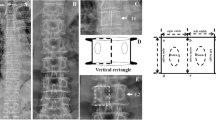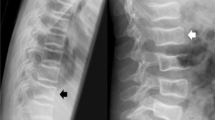Abstract
Assessment of vertebral fracture is critically important for the diagnosis and treatment of osteoporosis. This study aimed to clarify the effectiveness of the semiquantitative (SQ) method in the assessment of vertebral fractures in Japanese clinical practice. Forty-four physicians (seven experts and 37 nonexperts) assessed the spinal radiographs of 40 patients participating in the Adequate Treatment of Osteoporosis (A-TOP) Japanese Osteoporosis Intervention Trial (JOINT)-02 at the baseline, 12 months, and 24 months using the SQ method. The proportion of diagnosed fracture cases per spine was higher in the nonexpert group than in the expert group at each time point, and was especially high in the upper thoracic spine (T4–T6). The least mean squares spinal fracture index was significantly higher in the nonexpert group than in the expert group for all time points. The kappa statistics were also higher in the expert group than in the nonexpert group for all vertebral levels at all time points. Assessment of vertebral fractures using the SQ method tended to be overestimated by nonexpert physicians compared with the experts, with poor nonexpert interobserver reliability and well-matched expert interobserver reliability. Conscious efforts to avoid overestimation and to obtain higher reliability with the SQ method should be made to achieve more precise diagnoses and treatment of osteoporosis in Japanese clinical practice.



Similar content being viewed by others
References
Chesnut CH III, Skag A, Christiansen C et al (2004) Effects of oral ibandronate administered daily or intermittently on fracture risk in postmenopausal osteoporosis. J Bone Miner Res 19:1241–1249
Harris ST, Watts NB, Genant HK et al (1999) Effects of risedronate treatment on vertebral and nonvertebral fractures in women with postmenopausal osteoporosis: a randomized controlled trial. JAMA 282:1344–1352
Ettinger B, Black DM, Mitlak BH et al (1999) Reduction of vertebral fracture risk in postmenopausal women with osteoporosis treated with raloxifene: results from a 3-year randomized clinical trial. JAMA 282:637–645
Neer RM, Arnaud CD, Zanchetta JR et al (2001) Effect of parathyroid hormone (1–34) on fractures and bone mineral density in postmenopausal women with osteoporosis. N Engl J Med 344:1434–1441
Melton LJ 3rd, Lane AW, Cooper C et al (1993) Prevalence and incidence of vertebral deformities. Osteoporos Int 3:113–119
Eastell R, Cedel SL, Wahner HW et al (1991) Classification of vertebral fractures. J Bone Miner Res 6:207–215
Minne HW, Leidig G, Wüster C et al (1988) A newly developed spine deformity index (SDI) to quantitate vertebral crush fractures in patients with osteoporosis. Bone Miner 3:335–349
Sauer P, Leidig G, Minne HW et al (1991) Spine deformity index (SDI) versus other objective procedures of vertebral fracture identification in patients with osteoporosis: a comparative study. J Bone Miner Res 6:227–238
McCloskey EV, Spector TD, Eyres KS et al (1993) The assessment of vertebral deformity: a method for use in population studies and clinical trials. Osteoporos Int 3:138–147
Genant HK, Wu CY, van Kuijk C et al (1993) Vertebral fracture assessment using a semiquantitative technique. J Bone Miner Res 8:1137–1148
Wu CY, Li J, Jergas M et al (1995) Comparison of semiquantitative and quantitative techniques for the assessment of prevalent and incident vertebral fractures. Osteoporos Int 5:354–370
Grados F, Roux C, de Vernejoul MC et al (2001) Comparison of four morphometric definitions and a semiquantitative consensus reading for assessing prevalent vertebral fractures. Osteoporos Int 12:716–722
Crans GG, Genant HK, Krege JH et al (2005) Prognostic utility of a semiquantitative spinal deformity index. Bone 37:175–179
Shiraki M, Kuroda T, Miyakawa N et al (2011) Design of a pragmatic approach to evaluate the effectiveness of concurrent treatment for the prevention of osteoporotic fractures: rationale, aims and organization of a Japanese Osteoporosis Intervention Trial (JOINT) initiated by the Research Group of Adequate Treatment of Osteoporosis (A-TOP). J Bone Miner Metab 29:37–43
Orimo H, Nakamura T, Fukunaga M et al (2011) Effects of alendronate plus alfacalcidol in osteoporosis patients with a high risk of fracture: the Japanese Osteoporosis Intervention Trial (JOINT)-02. Curr Med Res Opin 27:1273–1284
Fleiss JL (1971) Measuring nominal scale agreement among many raters. Psychol Bull 76:378–382
Genant HK, Jergas M, Palermo L et al (1996) Comparison of semiquantitative visual and quantitative morphometric assessment of prevalent and incident vertebral fractures in osteoporosis. J Bone Miner Res 11:984–996
Delmas PD, van de Langerijt L, Watts NB et al (2005) Underdiagnosis of vertebral fractures is a worldwide problem: the IMPACT study. J Bone Miner Res 20:557–563
Acknowledgments
The authors thank the expert and nonexpert physicians for the assessment of the vertebral fractures using the SQ method. We also thank the A-TOP research group for providing the spinal radiographs of the patients participating in JOINT-02.
Conflict of interest
All authors have no conflicts of interest.
Author information
Authors and Affiliations
Corresponding author
About this article
Cite this article
Uemura, Y., Miyakawa, N., Orimo, H. et al. Comparison of expert and nonexpert physicians in the assessment of vertebral fractures using the semiquantitative method in Japan. J Bone Miner Metab 33, 642–650 (2015). https://doi.org/10.1007/s00774-014-0625-3
Received:
Accepted:
Published:
Issue Date:
DOI: https://doi.org/10.1007/s00774-014-0625-3




